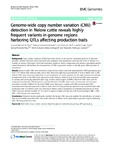Por favor, use este identificador para citar o enlazar este ítem:
http://www.alice.cnptia.embrapa.br/alice/handle/doc/1047683Registro completo de metadatos
| Campo DC | Valor | Lengua/Idioma |
|---|---|---|
| dc.contributor.author | SILVA, J. M. da | pt_BR |
| dc.contributor.author | GIACHETTO, P. F. | pt_BR |
| dc.contributor.author | SILVA, L. O. da | pt_BR |
| dc.contributor.author | CINTRA, L. C. | pt_BR |
| dc.contributor.author | PAIVA, S. R. | pt_BR |
| dc.contributor.author | YAMAGISHI, M. E. B. | pt_BR |
| dc.contributor.author | CAETANO, A. R. | pt_BR |
| dc.date.accessioned | 2016-06-22T11:11:11Z | pt_BR |
| dc.date.available | 2016-06-22T11:11:11Z | pt_BR |
| dc.date.created | 2016-06-22 | pt_BR |
| dc.date.issued | 2016 | pt_BR |
| dc.identifier.citation | BMC Genomics, London, v. 17, p. 1-14, 2016. | pt_BR |
| dc.identifier.uri | http://www.alice.cnptia.embrapa.br/alice/handle/doc/1047683 | pt_BR |
| dc.description | Background: Copy number variations (CNVs) have been shown to account for substantial portions of observed genomic variation and have been associated with qualitative and quantitative traits and the onset of disease in a number of species. Information from high-resolution studies to detect, characterize and estimate population-specific variant frequencies will facilitate the incorporation of CNVs in genomic studies to identify genes affecting traits of importance. Results: Genome-wide CNVs were detected in high-density single nucleotide polymorphism (SNP) genotyping data from 1,717 Nelore (Bos indicus) cattle, and in NGS data from eight key ancestral bulls. A total of 68,007 and 12,786 distinct CNVs were observed, respectively. Cross-comparisons of results obtained for the eight resequenced animals revealed that 92 % of the CNVs were observed in both datasets, while 62 % of all detected CNVs were observed to overlap with previously validated cattle copy number variant regions (CNVRs). Observed CNVs were used for obtaining breed-specific CNV frequencies and identification of CNVRs, which were subsequently used for gene annotation. A total of 688 of the detected CNVRs were observed to overlap with 286 non-redundant QTLs associated with important production traits in cattle. All of 34 CNVs previously reported to be associated with milk production traits in Holsteins were also observed in Nelore cattle. Comparisons of estimated frequencies of these CNVs in the two breeds revealed 14, 13, 6 and 14 regions in high (>20 %), low (<20 %) and divergent (NEL > HOL, NEL < HOL) frequencies, respectively. Conclusions: Obtained results significantly enriched the bovine CNV map and enabled the identification of variants that are potentially associated with traits under selection in Nelore cattle, particularly in genome regions harboring QTLs affecting production traits. | pt_BR |
| dc.language.iso | eng | eng |
| dc.rights | openAccess | eng |
| dc.subject | Bioinformática | pt_BR |
| dc.subject | Polimorfismo de nucleotídeo único | pt_BR |
| dc.subject | Genotipagem | pt_BR |
| dc.subject | Copy number variations | pt_BR |
| dc.subject | SNP genotyping | pt_BR |
| dc.title | Genome-wide copy number variation (CNV) detection in Nelore cattle reveals highly frequent variants in genome regions harboring QTLs affecting production traits. | pt_BR |
| dc.type | Artigo de periódico | pt_BR |
| dc.date.updated | 2016-06-22T11:11:11Z | pt_BR |
| dc.subject.thesagro | Gado de corte | pt_BR |
| dc.subject.nalthesaurus | Bioinformatics | pt_BR |
| dc.subject.nalthesaurus | Beef cattle | pt_BR |
| dc.subject.nalthesaurus | Single nucleotide polymorphism | pt_BR |
| dc.subject.nalthesaurus | High-throughput nucleotide sequencing | pt_BR |
| dc.subject.nalthesaurus | Genotyping | pt_BR |
| riaa.ainfo.id | 1047683 | pt_BR |
| riaa.ainfo.lastupdate | 2016-06-22 | pt_BR |
| dc.identifier.doi | 10.1186/s12864-016-2752-9 | pt_BR |
| dc.contributor.institution | JOAQUIM MANOEL DA SILVA, Unemat, IB/Unicamp; POLIANA FERNANDA GIACHETTO, CNPTIA; LUIZ OTAVIO CAMPOS DA SILVA, CNPGC; LEANDRO CARRIJO CINTRA, CNPTIA; SAMUEL REZENDE PAIVA, SRI; MICHEL EDUARDO BELEZA YAMAGISHI, CNPTIA; ALEXANDRE RODRIGUES CAETANO, Cenargen. | pt_BR |
| Aparece en las colecciones: | Artigo em periódico indexado (CNPTIA)  | |
Ficheros en este ítem:
| Fichero | Descripción | Tamaño | Formato | |
|---|---|---|---|---|
| APGenomeSilvaetal.pdf | 2,73 MB | Adobe PDF |  Visualizar/Abrir |









